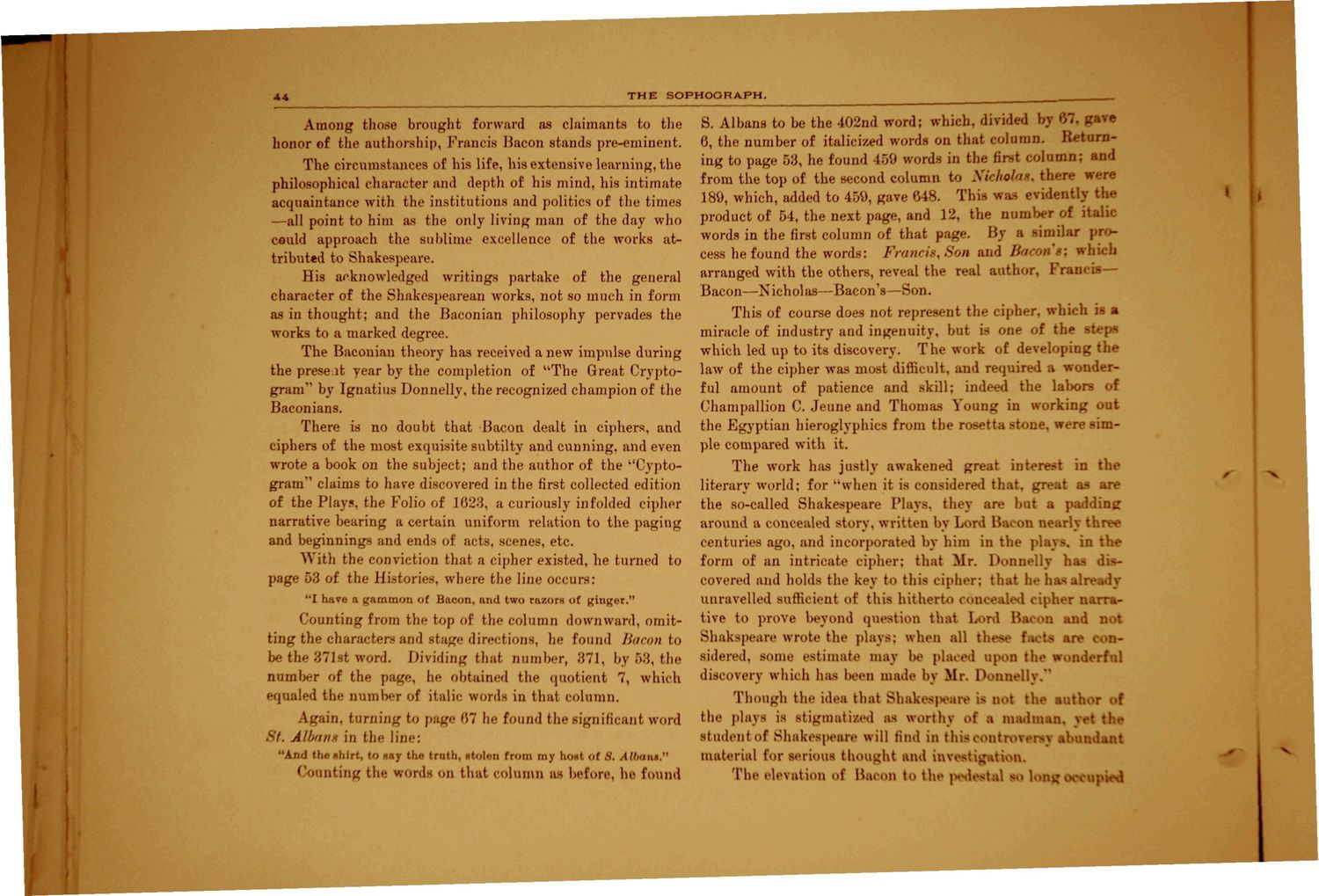| |
| |
Caption: Sophograph - 1890
This is a reduced-resolution page image for fast online browsing.

EXTRACTED TEXT FROM PAGE:
44 THI SOPHOCHAI'M. Among those brought forward as claimants to the honor of the authorship, Francis Bacon stands pre-eminent. The circumstances of his life, his extensive learning, the philosophical character and depth of his mind, his intimate acquaintance with the institutions and politics of the times —all point to him as the only living man of the day who could approach the sublime excellence of the works attributed to Shakespeare. His acknowledged writings partake of the general character of the Shakespearean works, not so much in form as in thought; and the Baconian philosophy pervades t\i^ works to a marked degree. The Baconian theory has received a new impulse during the prese it year by the completion of "The Great Crypto1 gram' by Ignatius Donnelly, the recognized champion of the Baconians. There is no doubt that Bacon dealt in ciphers, and cipher > the mosi exquisil f ilty and cunning, and even wrote a book on the Bubject; and the author of the "Cyptogram" claims to have discovered in the first collected edition of the Play, the Folio of 16 I, a curiously infolded cipher narrative bearing a certain uniform relation to the paging nd beginnings and ends of i cenes, etc. With the conviction that a cipher existed, he turned < • < page of tin- Histories, where the line occurs: "I have a gammon of Bacon, and two razors of finger." Counting from the 'op of tie- column downward, omitting the chi sand tage directions, he found Bacon to be th :Tl-t >rd. Dividing thai number, 871, by '>:'>. the Dumber of the page, he obtained tie- quotient 7, which <•' tie- /juiii f italic WOJ i in that column. A{ i. f'innj. he found the significant Word t. AIban in the Jin'*: j tif trail itolen from my )i •»f ,s\ A ibonM." { the on thai »luinn as before, he found 5. Albans to be the 402nd word: which, di b rn_ 6, the number of italicized wo - on tha J- B* ing to page .»:{, he found 459 words in I and from the top of the econd column to Ni L89, which, added to459, gave 648. Thu product of 54, the next page, and 12, the wr of itali words in the first column of thai f j • By a sii lar pr cess he found the word-: Fran ,Son ai Bo arranged with the other reveal the real aui -v. I * Bacon—Nicholas— 1 >n's—Son. > This of course does not rej sent the ciph< h is a miracle of industry and ingenuity, but is i e of the steps which led up to its di ry. The v. k of developing he law of the cipher was most difficull 1 required a wonderful amount of patience and skill: indeed the labors of Chanipallion C. Jeune and Thomas i g i:. irking out the Egyptian hieroglyphics from the rose- i >tone, were simple compared with it. The work has justly awakened grt ii rest in the literary world; for "when it i> col dered tl great as are the so-called Shakespeare Plays, they are but a padding around, a concealed - ry, written bv Lord H . on ne centuries ago, and incorporated by him in I plays, in th form of an intricate cipher; tl Mr. 1' Qnelly has d covered and bold- the key to th ipl nit 1 hasalread unravelled sufficient of this hitherto eale ^narrative to prove beyond (pr ion tl i 1 Ba . and *t Shakspeare wrote the plaj when all eee facts are t iide 1. some estimate may be p U] n the Wond ii d ?ery which has been made Mr Do Though the idea that Shakesp • >• author of the plays is iti/.ed as u thj a n lina tudciif of Shakespc ml in this material f.»r >l!8 thought 1 i: i. The ele\ at Ion of 1 n to the i 1 a] so I •
| |